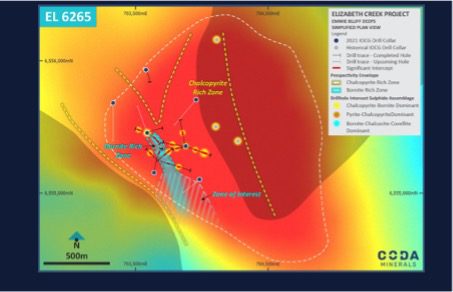Coda Minerals Limited (ASX: COD) has received exceptional intersections from the next round of assay results from drilling at its Emmie Bluff Deeps IOCG prospect in South Australia.
Coda is the operator and majority owner of the Elizabeth Creek Project, holding a 70% interest alongside Torrens, which holds a 30% interest. Coda has an irrevocable option to acquire an additional 5% of the Elizabeth Creek Copper Project by paying $ 1.5 million to Torrens at any point from the current time up to 60 days from a decision to mine.
Assay results have been received for four holes for which visual estimates were released in October 2021; two parent holes DD21EBD0002 (EBD2), DD21EBD0003 (EBD3)and two wedge holes DD21EBD0002W1 (2W1)and DD21EBD0003W2 (3W2).
Sections of diamond drill core which were considered to be most prospective were prioritised for rapid turnaround of processing and assaying. Additional assays from less prospective parts of the holes, as well as from the thick, low‐intensity disseminated and blebby chalcopyrite zones in the basement granite from holes 2W1 and 2W2 are expected in coming weeks. Further holes are either still being processed or are pending results from the assay lab (see table 2 below).
CEO, Chris Stevens, said the most significant results came from 3W2, a wedge hole drilled to the northeast from EBD3, which was collared approximately 300m due south of the Emmie Bluff Deeps discovery hole, DD21EB0018. This hole encountered a significant structure from approximately 794 to 810.5m, before entering into a 26m zone of bornite mineralisation from 804m to 830m. This was then followed by a second intersection of a 42m within the lower lode dominated by chalcopyrite from 911 to 953m1.
“Hole 3W2 is our best assayed drill intercept at Emmie Bluff Deeps to date. The aggregate result of 68 metres of high-grade copper-gold mineralisation comprising two intervals of 26m at 1.95% Cu and 42m at 1.2% Cu confirm previously released visual results and highlight the presence of a high-grade bornite zone within the deposit.
“Based on recent visual intercepts, we expect that drillhole 3W3B, currently pending assay results, will return a similarly positive and potentially thicker intercept of bornite in the higher-grade upper lode, confirming the increasing trend of thickness within this high-grade zone towards the south-east.
“Beyond hole 3W2, we are continuing to demonstrate the classic IOCG sulphide zonation within the deposit – with a bornite zone now confirmed by assays from holes EB18W2 and EBD3W2 and the broader chalcopyrite halo intercepted by multiple mineralised holes.
“With these assays, we have now confirmed the expected transition to a pyrite dominated suite in EBD2, which would typically signal the edge of the mineralisation in an IOCG deposit. However, thanks to recent drill successes from drillholes 2W3 and 2W4, we know, based on visuals, that some of our thickest chalcopyrite dominated copper mineralisation comes back to the east and the north of hole 2, and very likely to the south as well.
“It will be a major priority to follow up on these encouraging signs and the potential for an enormous increase in lateral extent around EBD2. We are also very excited about our new parent hole EBD4, which is targeting the most prospective area to date – the interpreted thickening trend of the high-grade bornite zone to the south-east of EBD3W3.
“As of Monday this week, our field crews have now demobilised for a brief but well-earned Christmas and New Year’s break. I would like to take this opportunity to thank all of the contractors, consultants and employees who have worked so hard for us this year and look forward to recommencing fieldwork in the first week of January as we progress this exciting and growing IOCG discovery.”
For further information please visit: https://www.codaminerals.com/












